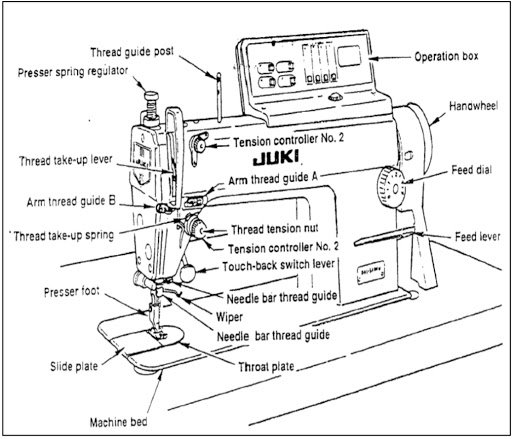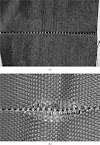Introduction to Sewing Machine
Sewing machine is very important machine for the garment industry. Sewing machine has made lots of improvisation in last 2 decades. Many advanced features is now installed in the sewing machine.
Let’s take an overview of the basic sewing machine parts –
1. Foot Pedal –
Foot pedal is used to control the speed of the sewing machine by applying pressure on it. Speed is depends on how much pressure we are applying on the pedal. Less pressure will run the machine slow while more pressure will run the machine in speed. Foot pedal is located on the floor, below the foot.
2. Spool Holder –
Sewing thread is mounted on the spool holder. In threading, spool holder comes in first step for mounting sewing thread. Their are 2 types of spool holder, one is vertical and second is horizontal. Type of spool holder is selected according to the winding pattern on the sewing thread. Usually vertical spool holder is used widely in garment industry.
3. Bobbin Winder –
It is used to wound the sewing thread on the bobbin. This bobbin winder is located on the top of machine bed or front to the machine or besides the machine. It has one lever which is used to lock the bobbin for winding while running the sewing machine.
4. Thread Tensioner –
Tensioner is located in the front side of the sewing machine. Their are usually two tensioners with tension disc in which sewing thread is passed. It is responsible for providing the sewing thread with even tension to get the perfect stitches.
5. Stitch Length Regulator (Feed Dial) –
It adjust the length of stitch made by the sewing machine. It has arrangements from 0 mm to 5mm or may be more than that depending upon the machine manufacturers. When we rotate the dial, the arrangement of feed dog is changed as it feeds the amount of fabric as per stitch length. It can change the stitch per inch (SPI) by changing stitch length.
6. Thread Guide –
As name suggests, it guides the thread through all the threading path. It avoids sewing thread displacement and keep it in the right direction. It is also responsible for carrying the maintained tension in the sewing thread.
7. Thread Take Up Lever –
Take up lever provides the required amount of sewing thread to needle, when it moves u and down. The downward movement of take up lever provides the thread while upward movement results in thread tightening to complete the stitch.
8. Presser Foot –
Presser foot applies the required amount of pressure on the fabric while stitching. The pressure can be adjusted by rotating presser spring regulator. Pressure should not more or less because more pressure can cause feed dog mark on fabric while less pressure can cause fabric slippage while stitching.
9. Feed Dog –
Feed dog feeds the required amount of fabric as per the stitch length is concerned. Feed dog moves clockwise and counter clockwise to move the fabric forward and backward respectively. Feed dog has texture on it’s surface like tooth, spikes, etc. for the purpose of grip to move the fabric.
10. Needle –
The most important part of the sewing machine is needle. Needle helps the sewing thread to pass through the fabric and form stitches. Needle penetrates the fabric along with sewing thread in it’s needle eye which cause formation of needle loop which is catch by the hook to form stitch.
11. Throat Plate –
Throat plate is removable part and has seam guides on it. Bobbin is located under this throat plate.
12. Hand Wheel –
Hand wheel rotates as we run the sewing machine. Stitching using hand wheel is used when a critical stitching is required with slow speed. We can control stitching very slowly using hand wheel.
13. Feed Lever –
Feed lever can be used for reverse stitching by feeding fabric backward. For this feed lever has press down until reverse stitching is finished. After reverse stitch is done just release the lever, it will come back to it’s original position and fabric will be fed in forward direction.
14. Operation Panel Box –
In latest modified sewing machine we can see this operation panel box which provides advanced technical features for the sewing machine. It helps in setting the stitch length, speed of the machine, stitch ttoe, etc.












0 Comments
If you have any doubts, please don't hesitate to ask